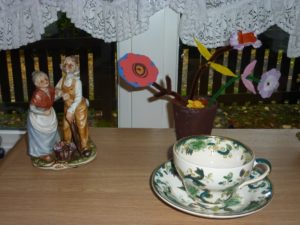How objects can build relationships in care homes

ENRICHEnabling Research in Care Homes
GUEST BLOG
How objects can build relationships in care homes
Melanie Lovatt is a lecturer in sociology at the University of Stirling. Her research interests include ageing, time and relationships. She is currently leading the ESRC-funded project Reimagining the Future in Older Age.
Melanie Lovatt provides an insight into the importance of material things through her exploration of how interactions with objects can shape the everyday lives of those living in care homes.

Between 2010 and 2016 I conducted a research study which explored how interactions with objects shaped the everyday lives of those living in care homes. My interest in this area was initially prompted by the question ‘what is it like to go from a life’s worth and a house full of things, into a care home?’ I was interested in what belongings residents took with them, how they interacted with their belongings, and how this might contribute to a sense of ‘being at home’.
As part of my findings, I learned how relationships were influenced by the display or gifting of things. I found that objects were important in maintaining relationships with family members, and also forming new relationships with other residents and members of care home staff.
Relationships with family members
Residents would display photographs and other meaningful belongings as one way to remember family members. Residents’ rooms contained items they had brought with them from their previous homes, but also sometimes objects they had acquired since. For instance Pam[1] showed off a ‘pipe-cleaner flower pot’, a recent gift from her son who had learning disabilities, that she displayed next to older ornaments. She laughed when she told me that when he had given it to her he had said “it won’t need much water!”

Relationships with other residents
Occasionally residents would give each other gifts, to mark a birthday or to recognise a friendship. When I visited Susan shortly after her 75th birthday, she showed me a necklace and earrings that another resident had given to her. I told her that this showed how she was valued by other residents, and she agreed, “it must do”.
Another resident, Annie, loved to crochet. One day she told me that she had crocheted a blanket for another resident, because she knew that her legs got cold. Small gestures such as these reflected the warmth that some of the residents felt for each other.
When a resident died and their family did not want all of their belongings, these would sometimes be offered to residents who had been close to them. Such items could take on ‘new lives’ while also helping residents to remember friends who had passed away. For example Susan showed me a teddy bear that had once belonged to a fellow resident. Susan laughed as she remembered how the other resident used to go ‘whizzing’ down the corridor in her wheelchair. She told me that her granddaughter now played with the teddy when she came to visit.
Relationships with staff members
Staff members were very important in the day to day lives of residents. When I visited the home I saw how staff and residents would chat about objects and furniture, perhaps commenting on a photograph of a new grandchild, or a vase of flowers that wasn’t there before. I noticed how casual conversations such as these were important in showing residents that staff paid attention to their rooms and the visitors they had received. It all helped to show residents that they were valued.
Many care home staff brought in objects for residents. Michael, who had no family close by and few belongings, had been given some furniture by his favourite carer. A different carer had bought a fridge magnet for another resident while she was on holiday. Residents were pleased when carers and cleaning staff noticed new items in their rooms, and sometimes residents would draw attention to particular objects. Such gifts and conversations helped to maintain a close relationship between carers and residents.
Unfortunately I found that not all interactions between staff and residents were positive. On one occasion when I was talking to a resident, a carer came in and, without asking, looked inside a box of gifts that the resident had recently received. The resident told her off for being nosy, and later told me that this wasn’t the first time the carer had gone through her things. It was clear to me that the carer had invaded the resident’s privacy. Although this was the only time I witnessed this behaviour, I wondered if it happened to other residents, and if they felt able to complain.
What benefits might this research offer care homes
My research reveals a number of ways in which care homes could use objects to enhance residents’ relationships and social interactions:
- Care home staff should be encouraged to take an interest in resident’s belongings. This could be as simple as complimenting residents on their possessions and commenting on new items. It could also include encouraging residents to talk to each other about their belongings, to share stories and identify common interests.
- Staff should pay attention to how everyday items such as televisions and chairs could be arranged in order to encourage conversations between residents.
- Care homes could consider having regular jumble sales or similar events. Such occasions provide opportunities for residents – especially those who have difficulty leaving the home- to buy gifts for family and friends, thereby helping them to reinforce valued relationships.
- Staff should treat residents’ belongings with respect
While these activities might seem simple, they can go a long way to making residents feel valued. At a time when residents may be at risk of feeling lonely, finding ways to get them talking to other people can be very important. Care homes often encourage residents to bring possessions with them to personalise their rooms. My research shows that in addition to this, care home staff should talk to residents about their belongings, and use objects to make connections between people.
If you would like to know more about this study, please click here for access to my paper.
[1] All names are pseudonyms